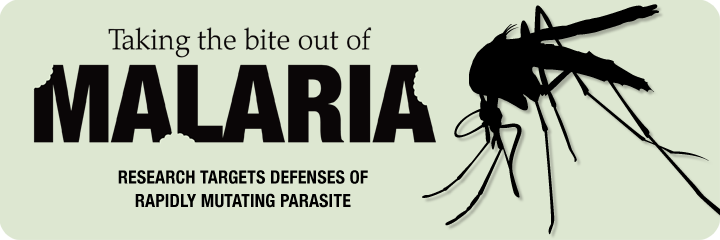
Humankind and malaria have been locked in an evolutionary arms race for thousands of years.
The past century has seen major advances on our side, in the form of anti-malaria drugs and improved public health. But because the parasite has a generational lifespan of weeks or months and exists in vast populations within each infected host, it’s often able to stay many steps ahead of us, developing mutations to evade our medications.
Meanwhile, this war exacts a terrible toll: Every year, more than 500 million people become severely ill with malaria. More than a million of them die.
J. Koji Lum and his colleagues at Binghamton University want to take a closer look at how the malaria parasite Plasmodium falciparum evolved resistance to chloroquine, the best weapon humans have ever had in the fight.
Lum, associate professor of anthropology and biological sciences, and Ralph Garruto, professor of biomedical anthropology, have about 11,000 archived human blood samples from malarious regions of the Pacific collected from the 1950s to the present.

A $1.5 million grant from the National Institutes of Health will allow them to analyze these samples and document the accumulation of genetic changes that resulted in chloroquine’s treatment failure in the Pacific.
“We’re on this treadmill running as fast as we can to create these medicines just to keep up with the relatively rapid mutation rate of the parasites,” Lum said. “Our project is trying to say, ‘Look, the most successful anti-malarial drug in history was chloroquine. It lasted for decades in some regions of the world. It’s still effective in some areas like South America.
“‘Can we, by examining how the falciparum parasite evaded this medicine, gain insights into slowing down the treadmill a little bit, trying to figure out ways that we can use medicines more intelligently? Are there insights we can gain from the failure of chloroquine to allow us to get the most bang for the buck from the new anti-malarials?’”
Other researchers have speculated about the parasite’s genetic mutations, but no one has ever been able to document the path it actually took to its current status.
The World Health Organization estimates that malaria causes an average loss of 1.3 percent annual economic growth in countries with intense transmission. Some 40 percent of the world’s population is at risk of malaria, which disproportionately affects young children in sub-Saharan Africa.
Lum argues that global warming, which is expanding the tropical regions of the globe, and a global economy, in which parasites and mosquitoes can move across borders with goods, money and people, should spark renewed interest in malaria among people in developed countries.
“All vector-borne diseases, everything that relies on a mosquito, are going to become bigger problems as our temperatures increase and the variance in our weather patterns increases,” Lum said. “And the time it takes to move around the planet is a small fraction of the incubation time for our diseases.”
page 1 | page 2